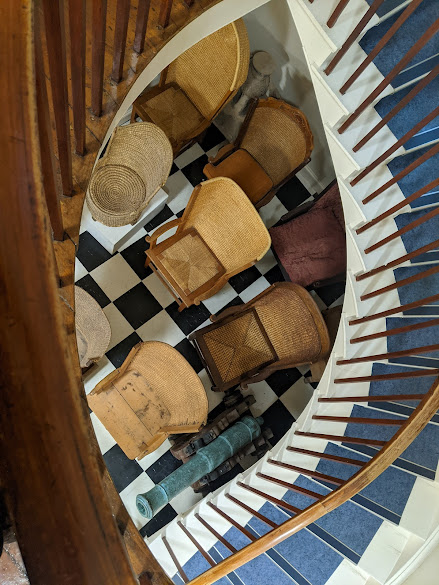I recently emailed my boss to let him know that I would be taking a couple of hours off work to pick up a Victorian "chandelier" from a local auction house. The word I had wanted to use was "electrolier", but not everyone knows what this is, so I had dumbed things down to avoid confusion, if somewhat at the expense of accuracy. The latter never sits well with me. :-)
Later in more relaxed conversation with my colleagues, my conscience kicked in, and I explained that chandeliers are technically light fittings for candles, from the French "chandelle" for candle. Gas light fittings are known as "gasoliers" and electrical light fittings are known as "electroliers". As all light fittings are electrical nowadays, the terms "electrolier" has become redundant. What I had bought had an electrical cable coming out the top, and bayonet light bulb fittings so, ergo, it was an electrolier. I noted to a colleague, that it actually looks like a gasolier because the arms had the characteristic swoop of a gas pipe but there were no taps, so it must have been an early electrolier when the style of of gasoliers were copied. All new technologies take on the look of older technologies, so customers are not scared away.
 |
| electrolier purchased at auction for Balintore Castle |
Anyhow, my brain must have been on the case, as I suddenly decided to re-examine the "electrolier" in those regions where the gas taps would have been. Close-up, there were definite signs that modifications has been made - the taps has been cut out and replaced by a barbell of brass. So what I had bought was once a gasolier and was now was an electrolier. Of course, the case for "once a gasolier, always a gasolier" may be argued instead. :-)
 |
evidence that the old gas taps have been cut out
|
The original finish on the fitting was fire-gilded brass. The technique involves painting on gold dissolved in mercury and then burning this off. The practice has naturally long since been discontinued. The lamp holders are just brass, and so they are a clear later addition: this is what one would expect in any case from the electrification. The candy-twist stem of the lamp is lacquered brass, so this also looks like a later addition. The puzzle is that the replacement brass barbells are also fire-gilded, so this suggests the modification from gas to electricity was a quality job and done a long time ago. One resolution to the puzzle, i.e. why the different modifications have different finishes, would be more than one phase of modification.
Anyhow, it is fun to apply Sherlock Holmes style deduction to the chandelier. The son of one of my restoration contacts has now, amongst his other accomplishments, become an antique light dealer. I first met him when he was 12! This was very early on the trail of Balintore Castle. Anyhow, he may be able to tell me more about the light fitting and give a professional valuation. My bid was well below the lower auction estimate, so no-one was more surprised and delighted than me when the lot came through.
One of the joys of the pick-up is that the auction house "The Pedestal" is based in the old dairy of the Stonor Park Estate. You can visit Stonor Park in the summer, but as it is out of season I had to be buzzed-in via an intercom through the electrically controlled main gates. By the time I had driven to Stonor, the sun has burned through thick mist and it was absolutely glorious. After many dull winter days, this was definitely a lift for the spirits.
 |
| my vehicle at the main gate of Stonor Park - amazing sunshine ! |
The main house was sadly scaffolded and under a canopy, but I did get a view of the 12th Century chapel and the prehistoric stone circle. My photos were rushed as the estate roads are single track and there were estate vehicles driving around, so there was no opportunity to stop. Remarkably, the house has been in the same family for 850 years.
 |
| Stone Park House (shrouded), 12th Century chapel and stone circle |
One of my bête noires, is the blanket expectation that, when doing up a grand room historic or otherwise, one of those cut glass wedding cake chandeliers is appropriate. This view attended the same Trumpian school of misguidedness as "I must have made it as I am decorating in Louis Quatorze". Most rooms (i.e. those not at Versailles) will not benefit from a wedding cake chandelier, and generally a more disciplined and coordinated design sits better.
Etymological Notes
One of my Mum's favourite facts was that another French word for candle is "bougie" which is the name of the North African port that exported candles to France. Bougie is now known as Béjaïa in Algeria. My family living room had a reproduction impressionist view of Bougie Harbour, so the tale came home, so-to-speak.
A bougie is also a tube-shaped medical device slim enough to be inserted into the body (choose your orifice) because the Algerian candles were long and slender.
Another French word for candle is "cierge", but this refers more to a taper.
A merchant who supplies goods for ships is known as a chandler, which was originally just a term for a candle-maker.
Candle is one of the oldest Latin-derived words in English, and this antiquity is likely related to religious observance.






















